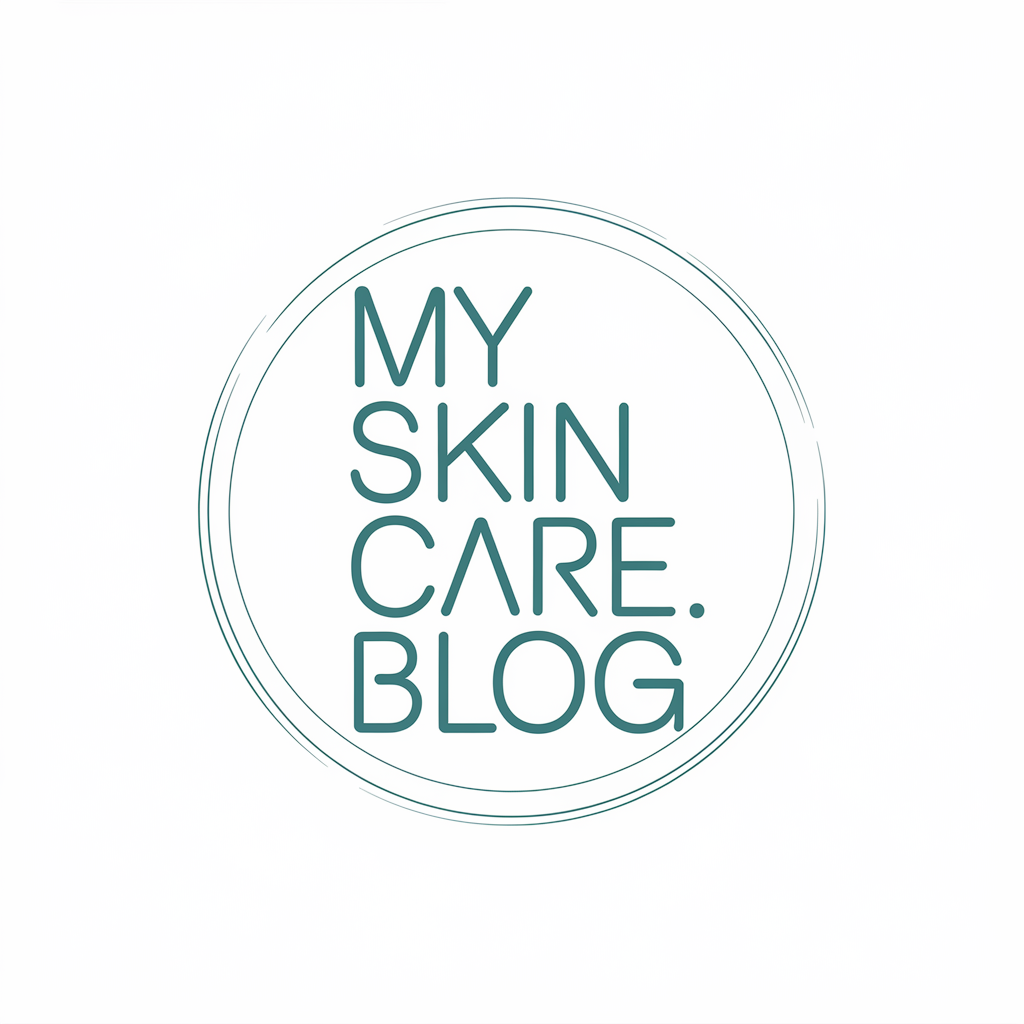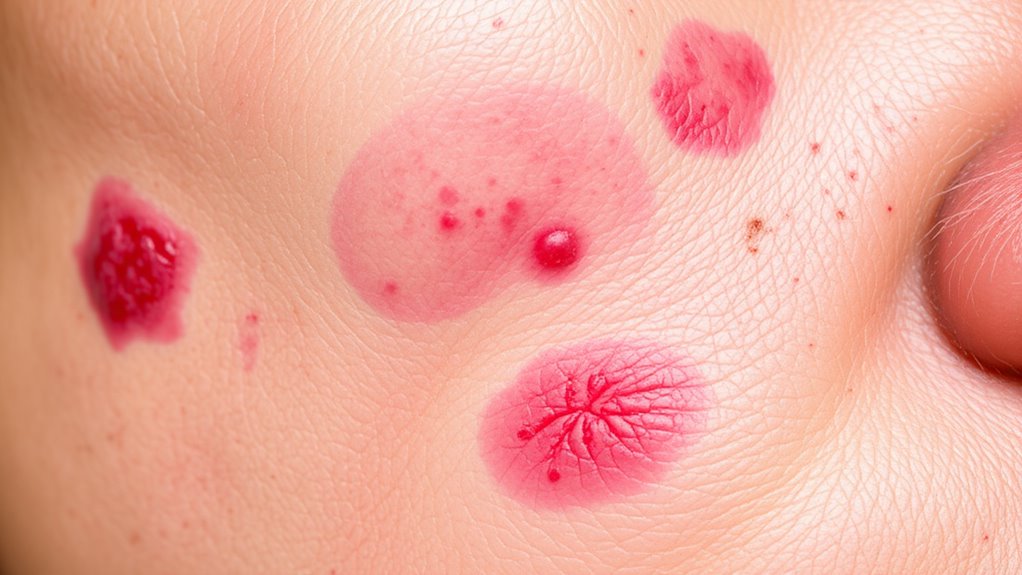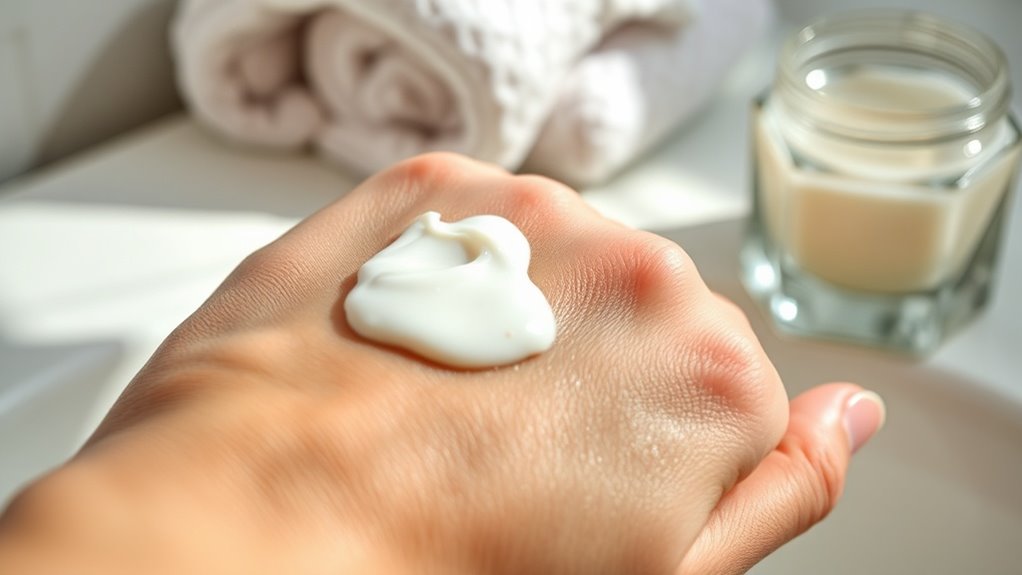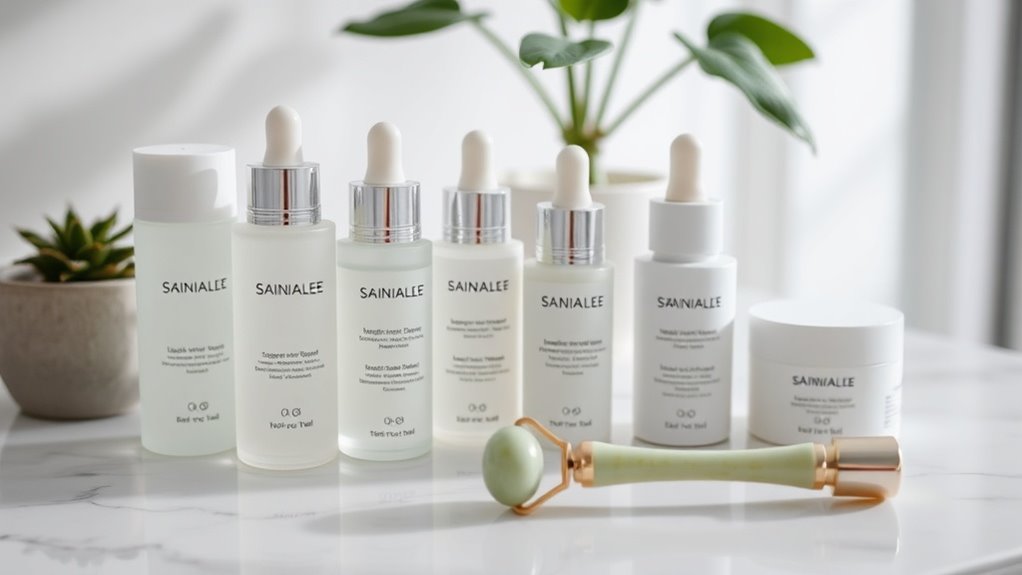What Really Causes Acne (And How to Stop It Fast)
Acne hits you hard when hormonal imbalances ramp up oil production, bacteria clog pores, and dietary triggers like sugary foods spark inflammation. To stop it fast, cleanse your face twice daily with a gentle salicylic acid product, apply spot treatments like benzoyl peroxide, and manage stress with quick relaxation techniques. You’ll uncover more effective strategies throughout to keep your skin clear and breakout-free.
Key Takeaways
- Hormonal imbalances increase oil production, leading to acne breakouts.
- Bacterial buildup in clogged pores causes inflammation and painful spots.
- High-glycemic foods and dairy trigger acne by spiking blood sugar levels.
- Stress elevates cortisol, worsening oil production and breakouts.
- Use benzoyl peroxide spot treatments twice daily for fast breakout relief.
Common Acne Myths Exposed
Many people believe several myths about acne that can mislead you into ineffective treatments. One common acne myth is that greasy foods directly cause breakouts; however, diet’s role is more complex than that. In fact, research highlights specific food triggers that can exacerbate acne based on scientific studies.
Another is that popping pimples clears them faster, but you actually risk scarring and infection.
Don’t fall for the idea that only teens get acne—it’s common in adults too.
To stay informed, you must rely on evidence-based advice from dermatologists, not folklore.
Dispelling these acne myths empowers you to choose proven strategies for clearer skin.
Additionally, recognizing everyday habits that unknowingly trigger acne breakouts is essential for effective prevention.
Understanding the Root Causes of Breakouts
You face acne breakouts when hormonal imbalances disrupt your oil production, bacterial buildup clogs your pores, or dietary triggers inflame your skin. For effective treatment, consider dermatologist-backed methods that can provide rapid relief based on expert recommendations.
Identifying these root causes lets you target the real issues behind your flare-ups.
Now, let’s examine how each factor plays a role in your skin’s health.
Additionally, psychological stress can trigger hormonal changes that exacerbate acne breakouts.
Hormonal Imbalances
Hormonal imbalances, such as elevated androgens, directly contribute to acne by stimulating the sebaceous glands to produce excess oil. You might experience breakouts during puberty, your menstrual cycle, or stress, which inflame pores and erode your confidence, making you feel frustrated and self-conscious.
To highlight the emotional toll and empower you, here’s a table of common signs:
| Sign of Imbalance | Emotional Impact | Practical Action |
|---|---|---|
| Oily skin | Insecurity and shame | Track your hormone cycles |
| Cystic breakouts | Low self-esteem | Consult a doctor quickly |
| Mood fluctuations | Overwhelm and anxiety | Adopt stress-reduction |
| Irregular periods | Frustration | Balance diet with nutrients |
Act now to regain control.
Bacterial Buildup
Bacterial buildup often follows when excess oil clogs pores, allowing opportunistic bacteria like Propionibacterium acnes to multiply and trigger inflammation.
You experience this as painful, red breakouts that signal your skin’s immune response. To manage it effectively, you must maintain a consistent cleansing routine; wash your face twice daily with a non-comedogenic cleanser to reduce bacterial colonies.
Avoid touching your face, as it transfers more bacteria and exacerbates the problem. If breakouts persist, you should seek professional advice for antibacterial treatments that target P. acnes without disrupting your skin’s barrier.
Stay proactive to minimize flare-ups.
Dietary Triggers
Dietary triggers play a key role in acne by fueling inflammation and oil production, often through high-glycemic foods that spike blood sugar levels.
You might notice breakouts after consuming sugary drinks, refined carbs, or dairy, as these raise insulin and stimulate your sebaceous glands.
Research confirms that a diet high in processed foods worsens acne by promoting bacterial growth and pore clogging.
To minimize this, choose low-glycemic options like leafy greens, whole grains, and omega-3-rich fish.
Track your meals for a week; you’ll reduce flare-ups by balancing your intake and supporting skin health effectively.
How Hormones Trigger Acne Flare-Ups
You notice how androgens, a key hormone, boost your skin’s oil production and clog pores, setting the stage for acne.
When your hormonal levels fluctuate, such as during puberty or your menstrual cycle, they trigger sudden flare-ups that inflame your skin.
Additionally, stress amplifies these effects by elevating hormone levels, making breakouts worse and harder to control. For individuals with sensitive skin, avoiding common skincare mistakes can help prevent further irritation and support overall skin health.
To manage these hormonal triggers without worsening the condition, it’s essential to adopt gentle skincare routines that avoid over-cleansing and harsh products.
Androgens Stimulate Oil
Androgens, the primary male hormones present in both genders, actively boost oil production in your skin’s sebaceous glands. This surge clogs pores, fostering acne by creating an ideal environment for bacteria.
You’ll notice how these hormones exacerbate breakouts, making oil control essential for clear skin.
-
Monitor your oil levels: Check for shiny skin or frequent breakouts to spot androgen effects early.
-
Adopt targeted skincare*: Use *non-comedogenic products that regulate sebum without stripping your skin.
-
Seek professional advice: Consult a dermatologist for personalized strategies to manage oil and prevent acne flares.
Hormonal Fluctuations Trigger
Hormonal fluctuations, such as those during menstrual cycles or puberty, directly trigger acne flare-ups by disrupting sebum production and skin cell turnover.
You experience this when rising androgen levels stimulate oil glands, leading to clogged pores and bacterial growth.
To manage it, track your cycle and note breakout patterns; this helps you anticipate flare-ups. Consult a dermatologist for hormone assessments or birth control options if you’re affected.
Maintain a consistent skincare routine with non-comedogenic products to balance oil and clear dead skin cells effectively.
Stress Worsens Breakouts
Stress intensifies acne flare-ups by spiking cortisol levels, which mimic the hormonal disruptions from events like puberty or menstruation.
When you’re stressed, cortisol boosts oil production, inflames pores, and promotes bacterial growth, making breakouts more frequent and severe. You can take control by addressing this cycle effectively.
-
Track your triggers: Identify stress sources like work or exams, then log how they correlate with your acne to spot patterns.
-
Practice stress reduction: Engage in daily activities such as meditation or exercise to lower cortisol and minimize flare-ups.
-
Adopt a routine: Combine stress management with a consistent skincare regimen, like gentle cleansing, to prevent hormonal impacts on your skin.
The Role of Diet in Skin Health
While diet alone won’t cure acne, it plays a crucial role in your skin’s overall health by influencing inflammation and oil production. By incorporating dietary changes from personal journeys, you can observe visible improvements in your complexion over time.
Research shows that high-glycemic foods, like sugary snacks and refined carbs, spike insulin levels, increasing sebum and breakouts. You can combat this by choosing low-glycemic options, such as whole grains and vegetables, which stabilize blood sugar.
Dairy products often trigger inflammation, so limit them and opt for plant-based alternatives. Incorporate omega-3-rich foods like salmon or flaxseeds to reduce redness.
Track your diet; you’ll notice clearer skin by prioritizing nutrient-dense meals for balanced hormones and healing.
Additionally, steering clear of processed foods can help mitigate skin issues by reducing exposure to harmful additives that promote inflammation.
Stress and Its Impact on Acne
The relentless pressure of daily life can exacerbate acne by elevating cortisol levels, which in turn ramp up oil production and inflammation in your skin.
You’ve likely noticed stress flares your breakouts, as it disrupts hormonal balance and weakens your skin’s defenses, making acne more stubborn. Managing stress can also help prevent premature aging by reducing its effects on overall skin health.
-
Track stress patterns: Log daily stressors to pinpoint when acne worsens, helping you anticipate outbreaks.
-
Incorporate relaxation techniques****: Use quick methods like deep breathing to swiftly lower cortisol and ease inflammation.
-
Adopt healthy routines: Prioritize sleep and balanced activities to mitigate stress’s physiological effects on your skin.
For immediate relief, consider incorporating overnight treatments to combat stress-related skin issues and promote clearer skin by morning.
Essential Skincare Habits for Clearer Skin
Adopting essential skincare habits transforms your acne-prone skin by targeting oil, bacteria, and inflammation directly.
You cleanse twice daily with a gentle, pH-balanced cleanser containing salicylic acid to remove excess oil and unclog pores without disrupting your skin’s barrier.
Apply a targeted treatment like benzoyl peroxide to eliminate bacteria and reduce inflammation effectively.
Moisturize with lightweight, non-comedogenic formulas to maintain hydration and balance oil production.
Use broad-spectrum SPF daily to protect against UV rays that exacerbate inflammation.
Exfoliate weekly with chemical agents to promote cell turnover, ensuring you patch test to avoid irritation.
Consistency delivers clearer skin.
These habits not only prevent acne but also aid in fading acne scars over time.
Additionally, salicylic acid helps exfoliate the skin from within pores, reducing acne lesions and preventing future breakouts.
Quick Fixes for Immediate Breakout Relief
When a breakout strikes, you quickly address it by applying a spot treatment with benzoyl peroxide or tea tree oil to kill bacteria and shrink pimples within hours.
This targeted approach reduces inflammation and prevents worsening, delivering fast, science-backed relief while minimizing side effects.
To effectively manage breakouts, follow these steps:
- Select a 2.5% benzoyl peroxide gel for gentle yet potent bacterial control.
- Apply sparingly to affected areas twice daily to avoid irritation.
- Pair with a non-comedogenic barrier to maintain skin hydration and integrity.
Natural Remedies to Combat Acne
While chemical treatments provide rapid results, you’ll discover that natural remedies like tea tree oil and honey effectively target acne by reducing bacteria and inflammation without harsh side effects. You’ll find these options scientifically backed and easy to integrate into your routine. For instance, aloe vera calms irritated skin, while green tea’s antioxidants fight free radicals.
| Natural Remedy | Key Mechanism | Practical Application |
|---|---|---|
| Tea Tree Oil | Antibacterial action | Dilute and apply twice daily |
| Honey | Reduces inflammation | Use as a spot mask for 15 mins |
| Aloe Vera | Soothes and heals skin | Dab fresh gel post-cleansing |
Incorporate these consistently for noticeable improvements.
Effective Over-the-Counter Solutions
While you’re exploring ways to manage acne, effective over-the-counter solutions like benzoyl peroxide options offer a powerful way to kill bacteria and reduce breakouts.
You apply these treatments directly to affected areas for quick results, making them a practical choice for daily use.
Salicylic acid treatments complement this by exfoliating your skin and clearing pores, helping you prevent future flare-ups.
Benzoyl Peroxide Options
Benzoyl peroxide tops the list of effective over-the-counter acne fighters, killing bacteria and unclogging pores with concentrations from 2.5% to 10%. This treatment penetrates your skin to target P. acnes bacteria, reduce inflammation, and promote cell turnover, making it a go-to for mild to moderate acne.
Start with lower strengths to minimize irritation and build tolerance.
-
Choose wisely: Select a 2.5% gel for oily skin or cream for dry types to suit your needs and avoid overuse.
-
Apply effectively: Cleanse first, then dab a thin layer on affected areas once daily, gradually increasing as your skin adjusts.
-
Manage side effects: Monitor for dryness or redness; use a gentle moisturizer and sunscreen to protect and maintain your skin’s barrier.
Salicylic Acid Treatments
Salicylic acid provides another effective over-the-counter option for acne, working as a beta hydroxy acid that exfoliates skin and clears clogged pores.
You penetrate deep into your pores to dissolve oil and dead cells, reducing inflammation and preventing breakouts. Choose products like gels or pads with 0.5% to 2% concentration, suited to your skin type—opt for oil-free if you’re oily.
Start slowly, applying once daily after cleansing, and always follow with moisturizer and sunscreen to avoid irritation. If you experience stinging, reduce use or consult a dermatologist.
Track improvements over weeks for consistent results.
Lifestyle Adjustments for Long-Term Skin Clarity
Achieving long-term skin clarity requires you to adopt key lifestyle changes that target acne’s root causes.
These adjustments address inflammation, hormonal imbalances, and bacterial growth scientifically.
-
Optimize your diet: Cut high-glycemic foods and dairy, as they spike insulin and promote oil production—studies show this reduces breakouts.
-
Maintain hygiene routines: Cleanse twice daily with non-comedogenic products and avoid touching your face to minimize pore-clogging bacteria.
-
Manage stress and sleep: Practice mindfulness or exercise regularly, since chronic stress elevates cortisol, worsening acne—aim for 7-9 hours of sleep nightly for hormonal balance.





